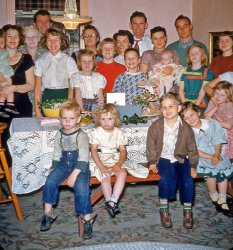
MAY CONTAIN NUTS

Search Shorpy
SHORPY ART

Framed or unframed, desk size to sofa size, printed by us in Arizona and Alabama since 2007. Explore now.
Join and Share
Ad-Free Shorpy
Shorpy is funded by you. Patreon contributors get an ad-free experience.
Learn more.

Recent comments
- Treescaping
- +112
- Rear View
- Way in the back --
- Button It Up
- And with an eye on the time ...
- Working in an enclosed ashtray
- Rear View Mirror?
- Tobacco cam
- Basic fact I learned only later in life
- Put a Lid on it!
- Pinstripes in the Tower
- Sound enhancement
- 3438 in '38
- Second Career
- Their days are numbered
- Only the Sensor
- Train control mechanism
- Rarest of the Rare?? & Classy 3400 Class
- Control Mechanism
- Those standpipes
- Wrenches
- International D-40 I believe
- Job prospects
- You had me at Train
- Land of the free
- Broad-Exchange Bldg
- Parking innovation
- The old block
- "Peck turned a sweet propeller"
Member Photos
The Shorpy
Printporium
Printporium
Search Shorpy
Search results -- 30 results per page
- Dime-Store Disaster: 1929
- ... exact cause of the explosion had not been determined last night, it was learned that the welded end of a 500-gallon tank in the boiler ... Posted by Dave - 04/20/2013 - 8:43pm -
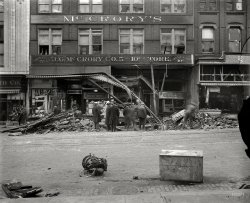
- Five-Alarm Candy: 1925
- ...
The cause of the fire had not been determined last night. It broke out in a supply of candy goods on the top floor. The entire ... it has become a joke, was no more willing to work last night than it has been in the past.
Washington Post, Jan 23, 1925 ... Posted by Dave - 07/13/2014 - 5:29pm -
![Five-Alarm Candy: 1925 December 28, 1925. "G.J. Mueller Fire." A five-alarm fire at George J. Mueller Candy Co. in Chinatown at 336 Pennsylvania Avenue N.W., in view of the Capitol. National Photo Company Collection glass negative. View full size.
Much-Maligned Water Tower Vindicated
Fireman Injured,
Traffic is Tied Up By $50,000 Blaze
Tower Proves Value In Checking Flames
A Spectacular five-alarm fire in the wholesale candy plant of George J. Mueller, 336 Pennsylvania avenue northwest, shortly before 5 o'clock yesterday afternoon wrought $50,000 damage, tied up street car services for more than fifteen blocks and resulting in the injury of one fireman.
The top floor of the five-story building was enveloped in flames when firemen arrived, and it was feared that the fire, fanned by a brisk wind, would spread eastward along Pennsylvania avenue. Smoke from the fire was carried eastward by the wind, forming great clouds around the Capitol.
The much-maligned water tower, which has failed at so many big fires, was given credit for checking the fire. The tower was lofted to a position directly in front of the blaze. For an hour it hurled water into the building, the stream being pumped by four engines.
Private Joseph A. Mayhew, of No. 2 engine company, suffered severe cuts on his hand when he picked up a broken hose connection. He was treated at Emergency Hospital.
The fire, which was in that section of town known as Chinatown, was witnessed by a crowd that overflowed the sidewalks for more than a block. The Chinese occupants of the rooming houses, stores and cafes looked on anxiously through the windows.
The first alarm was turned in at 4:50 o'clock, the height of the traffic rush hour. It was after 6 o'clock before street car service on Pennsylvania avenue was resumed, and many home-going government employees and office workers were forced to walk home or hire taxi-cabs.
Fire Chief Watson went to the fire on the second alarm. On his arrival he turned in three more alarms. District Commissioner Frederick A. Fenning, who has jurisdiction over the fire and police departments, arrived on the scene early. Maj. Edwin B. Hesse, superintendent of the police, also was on hand, as were Traffic Director M.O. Eldridge, Col I.C. Moller, his assistant, and various other officials of the fire and police departments.
The cause of the fire had not been determined last night. It broke out in a supply of candy goods on the top floor. The entire building had been swept clean of trash in preparation for an inventory, according to George J. Mueller, of the candy firm, who said he was at a loss as to the cause of the fire.
The stock of candy in the building was extremely low, Mr. Mueller said, because of Christmas sales. What was there, however, is believed to have been lost.
The loss caused by the fire entirely was covered by insurance, according to Carl Mueller, secretary of the firm. The stock, he said, was covered by $25,000 insurance, the machinery by $14,000, and the building by $20,000.
The candy firm was established in 1849 by Carl Mueller, grandfather of the present owners. The fire is the second in the firm's history. The last one, which was in another building, was started by a tramp who had been sleeping in the stable.
The buildings adjoining the candy plant - the William Lee undertaking establishment and the store of the National Mosaic Co. - were damaged considerably by water.
Fire Chief George Watson said that the principal difficulty confronting him and his men was to find places of vantage from which to fight the fire. The Mueller building is higher than either of the buildings which adjoin, and this increased the difficulty. The fire chief finally decided to battle it from the front and rear.
While the fire was at its height Chief Watson ordered three of his men to come down from a ladder on which they were directing a stream of water at the blaze. He was afraid that the ladder would collapse. So were the spectators, who were visibly relieved to see the firemen descend. The ladder was resting on a tree, which obstruction caused it to sag and lean far to one side. Water from the hose froze in the street. In addition the firemen had to contend with ice covered hose.
Washington Post, Dec 29, 1925
Background snarkiness reported on the water tower:
Two mishaps of fire apparatus interfered momentarily with the fire fighting, a hose bursting under the strain of the water pumped through it and the high water tower failing almost as soon as it was put in operation. It was quickly abandoned and its crew manned a hose-line.
Washington Post, Jan 11, 1925
The firemen were handicapped because of the difficulty in finding places of vantage from which to play their hose. The water tower, which has failed so many times that it has become a joke, was no more willing to work last night than it has been in the past.
Washington Post, Jan 23, 1925
National MosaicI want to know about the National Mosaic Co. -- did they just make tiles? Or complete mosaics?
["High-grade work in Mosaics, Interior Marble and Tiling," according to the company's ads. - Dave]
Mixed ReviewsMy first impression of this photo was to note how effective the water tower was as a firefighting tool. It looks pretty useful, I wonder why it was so universally panned.
[Because most of the time it didn't work? - Dave]
No. 2 EnginePrivate Joseph A. Mayhew, of No. 2 engine company, suffered severe cuts on his hand when he picked up a broken hose connection. He was treated at Emergency Hospital.](https://www.shorpy.com/files/images/SHORPY-15344u.thumbnail.jpg)
- The Fight: 1913
- ... a legitimate theater, a porno house and finally a rock night club, the NYC Landmarks Preservation Commission declared the interior and ... Posted by Dave - 03/09/2015 - 1:42pm -
![The Fight: 1913 New York, 1913. "Quality Shop and Hudson Theatre." Where the audience for Bayard Veiller's drama The Fight included a grand jury probing charges that the play was "indecent and a public nuisance." 8x10 glass negative. View full size.
The alphabet thiefis in town - see usiness en's unch.
I certainly hopethat those two usiness en enjoy their unch at Café Signage.
Business Men's LunchThree martinis and some pretzels.
Quality Replacement Letters could probably be purchased at the aptly named, and handily located, shop a mere two doors down.
[The letters are not actually missing, they're just semi-invisible thanks to the emulsions used in the days before panchromatic film. - Dave]
Red BMLI would surmise, as letters painted with that color would show up darker when using orthochromatic emulsion (no guess as to Pantone color shade though.)
Hudson Theatre is still thereIt's still in business at 141 W. 44th Street. After serving as a movie theater, studio for CBS and NBC, a legitimate theater, a porno house and finally a rock night club, the NYC Landmarks Preservation Commission declared the interior and exterior an official landmark in 1987. Now restored to its original 1903 appearance, the Hudson is part of the Millennium Broadway Hotel next door, and is used as a conference center and venue for special events.
Leo. Feist, Inc.Above the theater is one of the offices of Leo. Feist, Inc., as shown on the open windows and also by the large brass plate on the corner of the building. Leopold Feist founded and ran a music publishing firm in the early 1900s. By the 1920's, Feist was among the seven largest publishers of sheet music in the world. He had offices in major cities around he globe. His largest selling piece of sheet music was "My Blue Heaven" published in 1927. Emblazoned -- at least once on every music sheet he published -- was the slogan "You Can't Go Wrong With Any Feist Song". After his death in 1930, most of the Feist music catalog was acquired by MGM.
ComstockeryAccording to John Houchin's "Censorship of the American Theatre in the Twentieth Century", many early twentieth-century plays dramatized female sexual abuse (fueled by a moral panic over "white slavery"). What the authorities took exception to in "The Fight" was a confrontation set in a bordello, where the heroine (campaigning for public office) accuses her opponents of corrupting young women and the community for their own profit. In anticipation of the grand jury's visit, Veiller rewrote the second act and merely described the bordello scene, instead of showing it onstage, and after viewing the revised version, the grand jury dropped all charges.
(The Gallery, NYC, Stores & Markets)](https://www.shorpy.com/files/images/SHORPY-4a22195a.thumbnail.jpg)
- Washington Wizard: 1925
- ... the family had to pick up and move in the middle of the night several times because the Klan was on the way. My grandfather was a ... Posted by Dave - 06/12/2014 - 1:10pm -
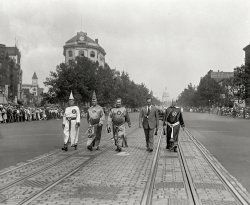
- To the Hounds: 1914
- ...
Meet the Beagles It must have been a hard day's night, 'cause they're working like dogs.
Not just the Haircut It is not ... Posted by Dave - 12/15/2008 - 1:31pm -
![To the Hounds: 1914 1914. Middleburg, Virginia. "National Beagle Club of America. Kennels and dogs of J.B. Thomas." Our second look at the Piedmont Hunt Club kennels. Before he took on the Red Baron, Snoopy had to chase a few foxes. View full size.
Meet the BeaglesIt must have been a hard day's night, 'cause they're working like dogs.
Not just the HaircutIt is not simply the grooming that makes the beagles appear distinct to modern eyes: selective breeding has changed the fundamental morphology of many common dog breeds in a mere hundred year. Check out some of the historical photos of various pedigrees linked at MessyBeast.
Piedmont Kennels First
Field Trials at Leesburg Prove Highly Interesting
The Piedmont kennels, of Middleburg, Va., have shown the other kennels the way during the first two days of the twenty-sixth annual field trials of the National Beagle Club of America. There has been nothing fluky abou the work of the Loudoun county dogs so far. They have worked their way to the fore by sheer superiority and fine handling.
...
Among those following the trials today were Mr. and Mrs. Joe Thomas, ...
Washington Post, Nov 7, 1915
The Beagles>> Maybe because they let their hair grow out.
Dave, you crack me up. I don't know that everyone got that.
[Yeah yeah yeah. - Dave]
BeaglesThey sure have a different look than the Beatles nowadays.
[Maybe because they let their hair grow out. - Dave]
A Christmas Beagle Story...Gosh, they look a LOT like the Bumpus hounds!
How the Hounds Have ChangedToday on the east coast, most packs are PenMaryDels, a type of foxhound known for their speed.
These guys look to be a little bit of everything but quite capable of giving a good day's chase.
Fox HuntingToday's nabobs still organize fox hunts. Of course, this tradition has gone PC and been ruined; you're not allowed to kill the foxes anymore.
(The Gallery, Dogs, Harris + Ewing)](https://www.shorpy.com/files/images/04950a.thumbnail.jpg)
- Biking in Suburbia: 1968
- ... was a great place to go for a walk after a long night of hitting the books. I was working full time at the Market Basket on the ... Posted by Mvsman - 06/28/2014 - 10:55am -
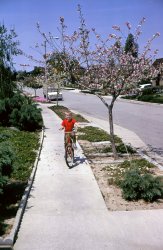
- Foot Traffic: 1942
- ... 130 E. Flagler Street, Miami, Florida. Exterior, night. Ross-Frankel Inc., client; Morris Lapidus, architect." Note the ghost ... Posted by Dave - 09/07/2013 - 11:42am -
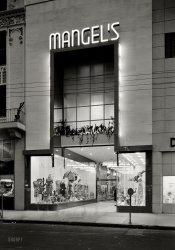
- Forty Winks: 1940
- ... your vehicle so if anyone else comes driving in during the night you won't end up getting run over because they don't see you.
(The ... Posted by Dave - 09/04/2012 - 2:09pm -
![Forty Winks: 1940 June 1940. Washington, D.C. "Negro driver asleep under a truck. There are no sleeping accommodations for Negroes at this service station on U.S. 1." Photo by Jack Delano for the Farm Security Administration. View full size.
I Think I'dPut chocks around those wheels.
FrühaufsteherWhat's the significance of FRUEHAUF (German for "up early") on the back of the truck?
[The trailer was manufactured by the Fruehauf Corporation. - tterrace]
Smart ManThis tired soul appears to have done the best with what he had to work with. He's under the truck for shade, using a bag of whatever he was hauling as a pillow and a small tarp to lay on instead of the hot, dirty, rock hard ground. Young drivers of modern day wouldn't know how to survive without the super size sleeper, GPS, internet hook-up, power this and that, satellite TV, air ride seats etc.
Green BookThe Negro Motorist Green Book, 1949 edition, is actually online here, and you can see how bad it was for many people, not all that long ago.
Drove North, still found segregationAlthough the state abbreviation is cut off in the photo, the only 1940 state license plates I'm aware of that featured "OCTOBER 31 40" across the bottom are from South Carolina. According to this site the plates were black over yellow.
Some years ago I read one of Peter Egan's "Side Glances" columns in Road & Track in which he described finding a 1950s-era road atlas designed specifically for black travelers. The atlas was designed to help the traveler deal with finding food, fuel and lodging in a segregated America. Sad to think such a publication had to exist, and that the driver pictured may have benefited from it. (Edit: Thanks auntjess for finding that!)
This photo serves to remind us that the nation's capital was once a Southern city in more ways than one.
A Permanent RestAs I truck driver I can sympathize with this guy--it's very uncomfortable to have to sleep in your seat. Having said that, it beats dying. The trucks of that era had one air tank for their brakes, if they even had air brakes at all. If it started to creep then I hope this man had some serious yogi skills to survive being crushed. Hopefully he had the good sense to chock one of the front wheels. I would have opted to sleep on the end of the flatbed.
Pillow talkThe fella looks like he is using a bag of grain for a pilla. Times they were tough. WOW!
Old Army trickThis reminds me of an old US Army trick my godfather told me about when I was young.
Setting up your sleeping gear under your vehicle so if anyone else comes driving in during the night you won't end up getting run over because they don't see you.
(The Gallery, Cars, Trucks, Buses, D.C., Jack Delano)](https://www.shorpy.com/files/images/SHORPY_8a34404a.thumbnail.jpg)
- Gotham Noir: 1933
- ... it one of the "filter" tricks to just make it look like night? I couldn't help but notice that there are no lights on in any of the ... Posted by Dave - 05/29/2013 - 2:27pm -
![Gotham Noir: 1933 March 15, 1933. "New York city views. Financial district from Hotel Bossert." Large-format acetate negative by Gottscho-Schleisner. View full size.
Tallest buildingsThe three tall buildings in the center of this view, from left to right: 20 Exchange Place (flat top); 40 Wall Street, aka the Trump Building (dark spire top); and 70 Pine Street, formerly the Cities Service Building (light spire top). None were more than a couple years old when this picture was taken.
What with the Great Depression and then World War II, there wouldn't be any more significant skyscraper construction for many years, and when construction finally resumed most buildings would have the more contemporary curtain-wall appearance. Masonry construction as seen in these buildings would seldom be used again. Samuel Gottscho really was documenting the end of an era in this picture, though of course he didn't have any way of knowing that.
For many years, the Hotel Bossert in Brooklyn Heights was owned by the Jehovah's Witnesses as part of their vast (4+ million square feet) Brooklyn headquarters complex. A few years ago, however, the denomination rather abruptly announced that it would be moving about 30 miles upstate and put all of the Brooklyn properties on the market. A private developer bought the Hotel Bossert about a year ago and announced plans to convert it into an upscale "boutique hotel." I don't know how much if anything has been done.
[Note: Samuel Gottscho may not have been able to predict the decline of commercial construction, but he was able to cope with it. When his business of architectural photography tailed off, he switched to nature and botanical photography and became highly acclaimed in that field. An interesting bit of trivia is that he did not take up photography until age 50, yet remained active until shortly before his death in his late 90's.]
WowMy new desktop for sure.
Of Time and the RiverI like to think that this stunning scene is just about what Thomas Wolfe could see from his Brooklyn apartment when he gazed at Manhattan in 1933.
Wow indeedI think that pretty much sums it up.
Looked so much betterThe setbacks formed such a better looking skyline than the modern rectangle boxes. I'm no fan of the International style.
What Time of Day?When do you think this picture was taken? Maybe early morning - sky/clouds visible and light reflections on one side of the buildings? Or was it one of the "filter" tricks to just make it look like night? I couldn't help but notice that there are no lights on in any of the buildings.
[Sunset. West is to the left. - Dave]
(The Gallery, Boats & Bridges, Gottscho-Schleisner, NYC)](https://www.shorpy.com/files/images/SHORPY_5a18138u.thumbnail.jpg)
- Bottle Boys: 1909
- November 1909. "Night scene in Cumberland Glass Works, Bridgeton, N.J." Making bottles one ... Posted by Dave - 06/08/2015 - 1:12pm -
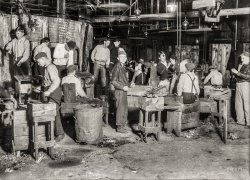
- The Barge Office: 1900
- ... of New York had expired.
In June 1897, a disgruntled night watchman set fire to the Ellis Island facility, causing so much damage ... Posted by Dave - 04/06/2014 - 7:45pm -
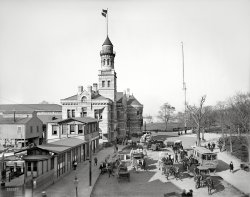
- Hoosac Tunnel: 1907
- ... and while current traffic tends to be later in the day/night, a train can come by at any time.
(The Gallery, DPC, ... Posted by Dave - 08/11/2013 - 11:52am -
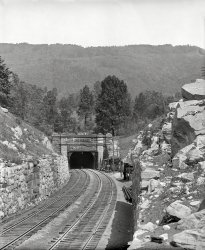
- Swing Your Partner: 1942
- ... in Weslaco, Texas. Drake family playing for a Saturday night dance." Medium format negative by the under-appreciated Arthur Rothstein. ... Posted by Dave - 11/06/2017 - 11:01am -
![Swing Your Partner: 1942 February 1942. "Farm Security Administration Mercer G. Evans camp in Weslaco, Texas. Drake family playing for a Saturday night dance." Medium format negative by the under-appreciated Arthur Rothstein. View full size.
This buildinglooks like it was also used as the local theater. Probably used folding chairs which are now stacked in a corner somewhere.
Girls dancing with Girls... and young boys too nervous, or shy.
[Or maybe the story this photo tells is of girls who'd rather wait for their turn with the man in the middle and waltz with each other, than dance with a bunch of grubby 12-year-olds. - Dave]
The saddest dance everMost of these people look like they were forced to show up for picture day.
Girls dancing with girlsNot surprising given the date. Enlistments were huge in early 1942.
Maybe I'll look older if I smokeThe young boy on the left appears to be getting ready to light up a cigarette. He may not impress the girls, but if his mother is there, he may get some unwanted attention.
First lessons?I'm no great dancer, but it's worth noting that nobody but the middle couple is positioned right; the man's right hand needs to gently pull at the lady's waist, and the woman's left hand needs to gently push him away on the shoulder. So I'd guess these folks are a bit new to dancing.
Hope they had fun anyways, and as a former nerdy, snot-nosed 12 year old (36 years ago), I hope some of those boys were in fact dragged out of their chairs in the same way I was back when.
Flash BulbInstead of lighting a smoke, I think the kid on the left is examining a flash bulb, probably a used one. What a great picture.
[I think you're right. -tterrace]
(The Gallery, Arthur Rothstein, Drake Family, Music)](https://www.shorpy.com/files/images/SHORPY-8b37743a.thumbnail.jpg)
- Cobb Cottage: 1900
- ... That house is so close to the street. Traffic noise at night must have been awful. Actually, probably so quiet your own heartbeat ... Posted by Dave - 02/10/2016 - 10:34am -
![Cobb Cottage: 1900 Circa 1900. "Nathan Cobb house, a summer cottage, Ormond, Fla." A residence built from materials salvaged from the wrecked schooner Nathan F. Cobb, which capsized and ran aground off Ormond Beach in 1896. 8x10 inch dry plate glass negative by William Henry Jackson. View full size.
Marine salvageIn the photo accompanying this article, you can see the ship's nameplate that used to be on the outside of the house.
Shocking!The device on the pole to the right of center looks like an early radio or TV antenna until you realize it's 1900!
[Radio got its start in the 1890s, with wireless marine telegraphy being the main application. There are more wires going into the tree, and a similar looking mast on the roof with a wire going to it. - Dave]
RailingsThe front porch looks like it is utilizing the Schooner rails quite effectively
Great treehouseAnd the perfect spot to ambush passing travelers to relieve them of their goods.
Still thereBought recently to keep it from being destroyed; story here.
NoiseThat house is so close to the street. Traffic noise at night must have been awful. Actually, probably so quiet your own heartbeat keeps you awake.
(The Gallery, Boats & Bridges, DPC, W.H. Jackson)](https://www.shorpy.com/files/images/SHORPY-4a08772a.thumbnail.jpg)
- Store Noir: 1940
- ... or going The blurriness of the photo (and being at night) suggests a long exposure, so the "ghosts" on the front step are probably ...
But a nice change, because we don't get a lot of night shots here.
The shadow on the street is classic, you couldn't ... Posted by Dave - 11/06/2018 - 4:12pm -
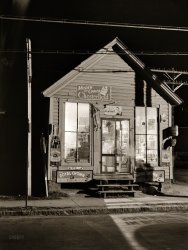
- Pierce Lumber: 1925
- ... blaze as a result of a bolt of lightning in last night's thunderstorm. Damage to five tenant companies was estimated at ... Posted by Dave - 06/23/2012 - 6:43am -
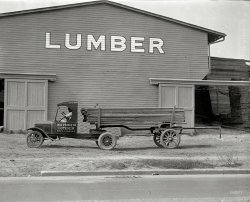
- Left on White: 1926
- ... on Sixteenth street were taken to traffic court last night.
Hard Left Turn The evolution of the left turn, as reflected in ... Posted by Dave - 09/13/2011 - 12:16pm -
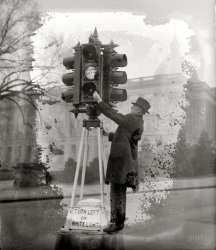
- American Gothic: 1923
- ... partly the photo and partly the season - Happy Twelfth Night, everyone! - and the Sherman house instantly recalled to me the classic ... Posted by Dave - 08/06/2012 - 1:57pm -
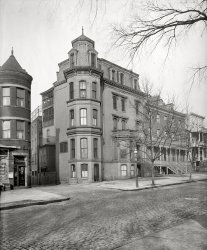
- Noble Riggers: 1905
- ... the allure of the steamers: “All day long until late at night, the Belle Isle ferries traveled up and down the river. … The fare was ... Posted by Dave - 10/02/2018 - 2:25pm -
![Noble Riggers: 1905 Detroit circa 1905. "Belle Isle ferry dock." A good place to pick up a yacht sail. The steamer Garland, seen earlier here. 8x10 glass negative. View full size.
Stove burnedThe giant Garland stove you remember was made of carved oak. It was moved from near Belle Isle to the state fairgrounds off 8 Mile in 1965. In 1974 it was disassembled and stored, but then was refurbished and returned to the fairgrounds in 1998.
In Aug. 2011, it was struck by lightning and burned.
Belle Isle from CanadaI grew up in Riverside (now Windsor) Ontario in the 1950s, and we lived on Esdras Place, just one block from the Detroit River. At the foot of Esdras there is a private park owned by the residents, and it looks directly across the river to Belle Isle. There were many kids on the block then, and that is where we learned to swim. There were picnics and parties held there though the summer.
The Kodachrome photo was taken by my father in 1955, and shows residents swimming in the river, with Belle Isle on the far side. The freighter steaming past is the Ralph Budd, which had an interesting history.
A sign in the 1906 photo indicates service to Bois Blanc, on June 7. It was also known as Bob-lo Island, downstream from Detroit. You can read more here.
"Naming rights"existed even in 1880, when the Garland was built, reportedly the first electrically-lit vessel on the lakes. She was named for the most popular model manufactured by Detroit's Michigan Stove Company; in return, the vessel's owner, Captain John Horn, had his new craft festooned in nickle-plated decoration, courtesy of the stove manufacturer. Indeed, the odd-looking mass ahead of the funnel is an example of that handiwork, a garland with the letter "G" inside. When I was a kid a gigantic Garland stove, at least two stories tall, dominated the approach to Belle Isle at Detroit, built for Chicago's Columbian Exposition. For all I know, it's still there.
The Garland endured quite awhile. Horner lost the vessel after the tragic accident involving mostly altar boys, referred to in the comments to Shorpy's original view of the ferry, when her builder, the Detroit Dry Dock Company, repossessed it. She continued in the Detroit-Sarnia service, renamed City of Sarnia in 1923, until removed from service in the early 1940s. She sank at the dock in 1945, and was dismantled in situ 1946-47.
Giggle, Giggle!One can almost hear the gleeful titters of the little girls in their summer frocks and straw hats, about to embark on an exciting voyage to exotic and storied foreign climes. Well, maybe those lands are still in the US and just across the river, but when you're five or ten, opportunities like this take on exciting aspects out of all proportion to the way adults reckon these things.
This is a view of the ferry dock at the foot of Woodward AvenueSure, you could travel a few miles down Jefferson Avenue and cross to the Island over a bridge, but for a dime you could cruise there in style on the Garland or its sister vessel, which began ferry service when Belle Isle opened in 1882.
In their 1957 book Made in Detroit, Norman Beasley and George W. Stark describe the allure of the steamers: “All day long until late at night, the Belle Isle ferries traveled up and down the river. … The fare was ten cents, and if the passenger so chose he could ride all day long for his original dime. … In the dusk of evening, the ride back to the city was exhilarating. The lights in the scattered high towers gave dimensions to Detroit; the growing skyline gave a sense of growing importance.”
Sadly, the last boat sailed in 1957.
Does your mother still dress you?Can anyone fill me in on why that one boy seems to be wearing a doily on his shoulders? This is not something that I have seen before, and I am wondering if it is a common article of clothing. It occurs to me that his mother might have thrown that over his shoulders as a sort of shawl anticipating cooler temperatures out on the water. Can anyone shed any light on this for me?
[Appears to be a kind of Fauntleroy suit. - tterrace]
June 7, 1906?Possibly circa on or shortly before June 7, according to the displayed timetable. Can't make out what the two words to the left of "June 7" are. "Best Blues"?
Bois BlancThe sign actually says "Bois Blanc" referring to another island in the Detroit River also known as Boblo Island.
(The Gallery, Boats & Bridges, Detroit Photos, DPC)](https://www.shorpy.com/files/images/SHORPY_4a16323a.thumbnail.jpg)
- Naughty & Nice: 1941
- ... http://insomniatheater.com/ where I can still listen all night with ear buds and my iPhone.
Jughead 1.0 The lad is sporting a ... Posted by Dave - 12/22/2018 - 11:04am -
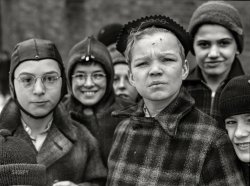
- Corner Story: 1939
- ... you can't do it right, Ain't ya glad we got Saturday night? -- New Christy Minstrels
Re: I Guess They Showed Up Early @jdowling23, before they start their Saturday night, they all go down to the crossroads to pay tribute to Robert Johnson.
... Posted by Dave - 11/05/2012 - 9:37am -
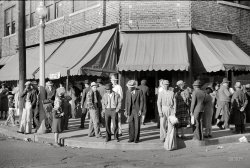
- Flirty Dancing: 1943
- ... stockings, saving their one precious pair for weekend date night wear.
One of the major cosmetics manufacturers, Max Factor, even ... Posted by Dave - 01/11/2017 - 10:47am -
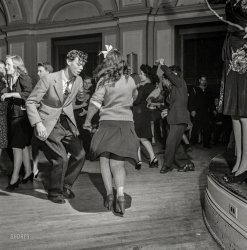
- Family Road Trip: c. 1955
- ... so similar to the places my family would stop at for the night,way back when. Black and white TV, perhaps a pool, and little old me was ... Posted by Elizabeth Thomsen - 02/03/2011 - 6:50am -

- Splendor in the Grass: 1942
- ... of the undershirt by not wearing one in It Happened One Night. Maybe he brought about the end of the swimsuit that covered the torso? ... Posted by Dave - 07/09/2020 - 2:34pm -
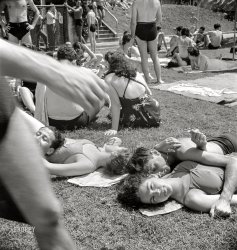
- Chicopee: 1911
- ... in WWII.
Then & Now I wonder how many hours a night these kids spend chatting on the internet.
Stanley Twarog I wonder ... Posted by Dave - 09/29/2008 - 9:06am -
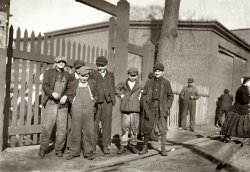
- Matzo Bowl: 1926
- ... bowler per game - 2 teams, 5 man each 3 games = $3.00 a night. I learned quickly how to keep score and moved up and out of the pits.
... Posted by Dave - 07/17/2017 - 11:12am -
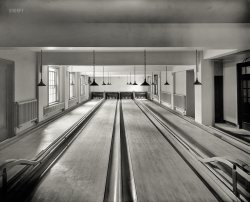
- Overpass Moderne: 1941
- ... Thanks to the comment by dongeeguy, which I read last night when I looked at the picture, I recognized this beautiful bridge when we ... Posted by Dave - 11/03/2019 - 2:57pm -
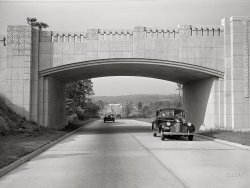
- Hotel Fire: 1963
- ... about the fire highlighted one group of hotel guests that night - adults and children in the tour company for "The Sound of Music" ... Posted by Dave - 07/23/2015 - 12:09pm -
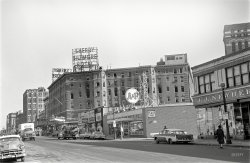
- Trip Advisor: 1902
- ...
The latter part of the Ocklawaha journey is made at night, and it is then that the river is seen most impressively after a fire of ... Posted by Dave - 08/15/2011 - 11:12am -
![Trip Advisor: 1902 1902. "Mr. Foster's office in Palm Beach." An outpost of the Ask Mr. Foster chain of travel agencies and souvenir shops started in Florida by Ward Foster in the 1880s. 8x10 glass negative by William Henry Jackson. View full size.
Ocklawaha?Where the heck is Ocklawaha? I might buy a ticket just to find out.
[It is both a town and a river. - Dave]
Philip Morris ain't hereAt first glance, I thought the boy was dressed in a red bellhop uniform like those who used to page people with phone messages at hotels i.e. "Call for Philip Morris!" but on closer inspection he seems to be a messenger or junior assistant of some sort. Also, just think, 109 years ago, somebody cut some lily of the valley out of their garden in the morning and put them in a water glass on their desk and still today they convey the beauty and fragrance of nature, my mom's favorite flower. The posters, postcards, travel photos, etc. pictured would today get you on TV in the Antiques Roadshow and be worth a hefty sum too. Carry on.
A room loaded with Shorpy fruitLook at those walls full of photos and those stacks of big brochures (or whatever travel agencies used then). One of the eye catchers for sure is the Ocklawaha Steamer Tickets sign (part of one was used for a window sign of some kind). A photo like this is why Google was invented, sort of, where I found some marvelous prose:
St. Johns and Ocklawaha Rivers
(Highways and Byways of Florida, 1918)
Palatka is the starting-point of the Ocklawaha steamers. They go south twenty-five miles, then turn west and enter the old forests of the "dark crooked water," which is what the name of the stream means in English. The journey ends at Silver Springs, one hundred and ten miles farther on. Enthusiasts call the Ocklawaha "the sweetest water-lane in the world," and the voyage through this liquid silent forest aisle is full of weird interest. Certainly no trip to Florida is complete which does not include an outing on this romantic stream with its ever-changing scenes and its tonic air laden with the balsamic odors of the forest.
The latter part of the Ocklawaha journey is made at night, and it is then that the river is seen most impressively after a fire of pine knots has been kindled in a big iron box on the top of the pilot-house. This blazes finely, and the light from the resinous yellow flames advances up the dark sinuosities of the stream in a manner that is enchantingly mysterious. The foliage which it touches is magically green, the festooning mosses are transformed to silvered garlands, the tree trunks turn to corrugated gold, and the black slimy stumps become jeweled pillars. When the fire dies down a little the distant scenery becomes indistinct and shadowy, and the great trees are pallid and ghostly. Then fresh knots are thrown in, the fire blazes up, and again the winding forest walls are brightly lighted amid the impenetrable surrounding mirk, while everything is reflected in the smooth water.
Ocklawaha and Silver RiversAs a photographer I wish I could go back in time and visit this place. I live near the Ocklawaha and Silver Rivers. They haven't changed much since the old days. Here is the Ocklawaha River today.
Here's the Silver River which starts at Silver Spring and flows into the Ocklawaha.
I fell in love with these rivers about 12 years ago and started photographing the flora and fauna. There is a high concentration of wildlife on these two rivers including rhesus monkeys which in itself is an interesting story as to how they got there. Even with the small boat sometimes it's hard to get through. After a big storm there's always trees blocking the rivers and in the old days they must have had a crew working full time to keep the waterway clear.
[One would be hard pressed to tell them apart. - Dave]
Hand Painted Art for sale Ah, hand coloring a black and white photograph. That is a lost art these days. Very few, if any photographers have the time or patience to sit down with a picture and a large box of watercolor type paints with which to hand color a photograph.
I used to do hand spotting of photos and that was hard enough matching the gray-tones to the photo.
Now it is all computerized as displayed on Shorpy.com. We have some artists who excel at digitally colorizing photographs, such as Don W.
Timeshift"Hedonism? Well! Certainly not, Sir!"
(The Gallery, Florida, The Office, W.H. Jackson)](https://www.shorpy.com/files/images/4a20521a.thumbnail.jpg)
- Kodachrome Crowd: 1952
- ... until 67-ish, the yellow was biggest and held the Friday night popcorn snack for mom, my brother and I. Pops was busy smoking and watching Friday night fights sponsored by Gillette in glorious 21" of black and white on the ... Posted by Vintagetvs - 12/06/2016 - 7:44pm -
